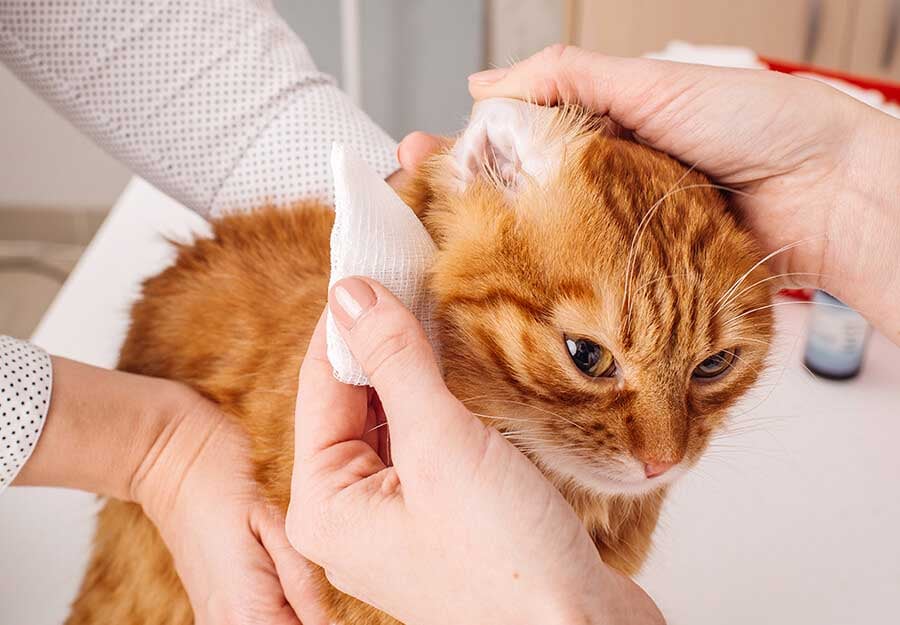How to Get Rid of Ear Mites in Kittens

Cats are avid groomers, but if you start to notice your cat paying particular attention to her ears, then you may be dealing with ear mites in cats. Cat ear mites aren't just a nuisance, if not treated properly they can leave lasting damage. Unlike other common pests, like fleas on cats, you probably won't see mites on your cat because they are just too small. They aren't quite microscopic, but they are pretty tough to spot. Instead what you'll see is the painful and frustrating symptoms of mites on cats. So what are these invisible pests that have taken over your cat's ears? Ear mites are parasites, scientifically named ear mites Otodectes cynotis. These little spider looking mites have Unlike many pests that drop their eggs, mites fulfill their entire life cycle while attached to your pet. This life cycle takes about 3-4 weeks in total, going through 5 different stages: The complete mite life cycle takes approximately 21 days, and a female adult mite can lay 5 or more eggs per day, allowing them to populate and potentially spread very quickly. Mites are highly contagious and opportunistic, so your cat can easily get mites from contact with any other animal that has mites. Typically, because mites complete their life cycle on their host, direct contact with an infected animal is the most likely way of contracting these pests, but they can spread without a live host in a very limited capacity. This could mean another pet in your house, a neighbour's pet, or even a wild animal. If you are thinking - But my cat is indoors! He's never interacted with another pet! - then the transitory host might be you or someone else in your house! That's right, cat owners can make a suitable host for mites too, though it is quite rare. Rather than set up shop on your skin, the mites may just use you as a means of travel to a more suitable and susceptible host, being your kitty. If your cat starts tilting her head it might look cute, but she could be dealing with an uncomfortable infestation. Cat ear mites are quite common, and fortunately, easily treatable. Some of the most common pests in dogs are typically less common in cats because many of our feline friends enjoy relaxing lives indoors, but there is one common pest that tends to affect outdoor cats more than dogs - ear mites. These tiny pests love the warm, moist environment of your kitty's ear canal. Before you see any pest activity, you will likely notice some common symptoms of ear mites in cats. Mites lead to severe itchiness that can drive your kitty nuts, so if you see your kitty favouring her ears, do a quick inspection to look for signs of pest activity. Here are some other visible symptoms of ear mites you may notice: Besides the usual skin conditions and reactions you typically see with irritation, you may see your kitty's ear starting to balloon. You may chalk it up to swelling from irritation, but excessive scratching and head shaking can actually lead to a more severe condition, called an aural hematoma. The force of scratching and shaking the ears can lead to small blood vessels bursting in the ears, causing blood to accumulate in between the layers of skin, inflating the ear. If you notice your cat's ear inflating, call your vet immediately. The longer you wait the more damage the hematoma can do. Treatment often requires surgery to properly drain the fluid and flatten the skin back to normal shape. Symptoms of ear mites in your cats can be mistaken for other issues, like allergies or yeast infections. These similarities can make it challenging to diagnose mites at home. If you know what to look for then you can treat and eliminate these pests quickly and easily. Symptoms of allergies and yeast infections can be similar to ear mites, but yeast has one very obvious sign - its pungent smell. Yeast has a very well-known smell, one that can be quite off-putting. Yeast is a fungus that always lives on your pet's skin, but allergies and a poor diet can often allow the yeast to bloom quickly. Yeast, like mites, loves moist and warm areas, so ears are one of the best environments for yeast to thrive. Even though ear mites are hard to see, it's not impossible. They are small and very light in colour, and can resemble coffee ground so you might see small white specks wiggling around, but more likely you will see the debris they leave behind. Ear mite poop is usually the easiest way to identify ear mite activity. They leave behind small dark specks that look like pepper in your cat's ear. They can also cause excess ear wax build-up, so your cat's ear may look dirty, even if you regularly clean your cat's ears. Alone this doesn't guarantee mites, because it could just be regular ear debris, but if you see what looks like pepper in your cat's ear and you find your cat is suffering from some of the most common symptoms of ear mites, then you likely have a pretty accurate diagnosis. If you don't see any evidence of mite activity, it's still a good idea to have your cat checked out by your vet to rule out other pests, allergies, or skin and coat issues that may need immediate attention. If you suspect your cat is suffering from an ear mite infestation, then don't panic. Mites may be unpleasant, but they are fortunately pretty easy to evict. In many cases, you may start by treating the symptoms. Trying to soothe the itch, or preventing infection seems like it would be the most effective solution to your cat's discomfort, but it's only a temporary solution unless you treat the underlying issue. Fortunately, ear mite solution for dogs and cats is a pretty easy-to-find, over-the-counter medication that most pet stores and vets can sell you. They are typically an oily formula that is dropped in the ear for a few days to a week to kill off the mites at all life stages. More severe infestations that have caused secondary infection or damage may require an antibiotic, so talk to your vet if you aren't sure of the right treatment for your cat's itchy ear issues. Natural treatments are quite popular, and there is plenty of anecdotal evidence to show the effectiveness of natural, home remedies for cat ear mites. Like most natural remedies, they are effective in most cases, but it's not a guaranteed cure for every case of ear mites. The best part about home remedies is not just that they are natural and free of chemicals, it's also usually that they are made of ingredients that you probably already have at home. In some situations, a natural remedy may not always be the right solution. If you are dealing with a severe infestation or secondary complications of ear mites, then talk to your vet about all of the treatment options to make sure you choose the safest one for your kitty. Let's take a look at 3 of the most popular home remedies for ear mites in cats: One of the most well-known and effective natural remedies for ear mites in cats is olive oil. It seems almost too simple to be true, but it is! Applying small amounts of olive oil to your cat's ear to basically suffocate the ear mites, prevent them from latching onto the skin, and make it easier to remove the mites and eggs by wiping your cat's ears out with a makeup pad or soft washcloth. The oil will also act as a soothing agent for the itchy reaction and will help to moisturize the skin and promote speedy healing. If you already lean towards natural remedies, then you likely have an arsenal of essential oils in your home to cure various issues. If so, you probably have an essential oil or two that can help soothe the itch and make your cat's ears a less than ideal home for the mites. Here are a few essential oils that mites hate: Essential oils have the potential to be dangerous when used on cats because they are so concentrated, so they need to be diluted with a carrier oil, like coconut oil or olive oil to be safe. Also, keep in mind that these essential oils shouldn't be ingested, they should only be used topically in places where your cat can't lick at them. If you are unsure of how to safely use essential oils with your cat, then we recommend a different treatment. Apple cider vinegar is a long-used natural remedy for many ailments and conditions, but you may not know how useful it can be for treating ear mites in cats. It's an effective anti-fungal and anti-bacterial, which can prevent and treat many secondary infections that can be caused by ear mite infestations, like bacterial or yeast infections. Additionally, apple cider vinegar can help to adjust the skin pH in your cat's ears making a less hospitable environment for the mites to survive. Apple cider vinegar alone may not be enough to completely eliminate the ear mites from your kitty when combined with one of the other natural ear mite solutions for cats. Ear mites may seem like a mild annoyance that's easy to treat, and they are, but if they go untreated for too long, they will start to do some serious damage to your cat's ears. Ear mites are literally feasting on your cat's skin, and they will start to do real damage to the delicate skin of their ears and deep into the ear canal if you don't act quickly. Your cat could end up with a bacterial infection that could do even further damage to the skin and spread beyond the ears. Mites love ears, but will opportunistically spread to any parts of your cat's body that provides a tasty food source. This could lead to intense itch, and even mange, the disease caused by a full-blown mite outbreak. One of the worst consequences of a rampant ear mite infection in cats is the risk of hearing damage. This damage can be either partial or full deafness in one or both ears. When bacteria makes its way down the ear canal to the drum or auditory nerves, it can cause permanent damage resulting in hearing loss for your cat. Even swelling in the ear canal from your cat scratching can cause temporary hearing loss. Timely treatment of the mites can protect your cat's hearing and reduce the risk of other secondary complications. With the right, timely treatment and appropriate after-care, ear mites are usually a simple fix, but as we always say with any pest infestation, prevention is the best method. You can't predict where mites will be or which animal they are travelling on, so the best way to protect your pet from mites is to keep them healthy. A strong immune system, healthy skin, and a good diet will make your cat a less ideal host for these opportunistic pests. Mites prefer an acidic environment, meaning low pH, so feeding a high-quality alkaline diet, like raw cat food, will deter mite activity. In addition, a regular grooming routine is a big part of your cat's overall skin and coat health. Routine ear care will help to protect the sensitive skin in your kitty's ears. Getting rid of mites is the first step, but depending on how bad the infestation is, and how much damage was done to your cat's ears, you may need to consider different methods for helping to heal your cat's ears after the mites have been eliminated. Residual itch, dry skin, open sores, and even fur loss will take time to heal, but you can help speed up the process and make your cat more comfortable. Here are some of the best topical treatments to support healing: Have you dealt with ear mites in cats? Share your tips, struggles, and success stories with us in the comments below! What are Ear Mites in Cats?
Ear mites bite into your cat's skin and latch on. They are a bit of a garbage pest, so they will feed on whatever debris passes by them, though blood and skin provide the most nutrients. These tiny little pests that can barely be seen by naked eye can do a lot of damage as they live their full life cycle attached to your kitty. They thrive in moist, dark, and warm environments which is why your cat's ears are the perfect home for ear mites to flourish.
Life Cycle of Ear Mites
How Did Your Cat Get Ear Mites?
Symptoms of Ear Mites in Cats

Aural Hematomas in Cats
Aural hemotomas can be very painful and can lead to further damage and possibly permanent disfiguration of the ear.
Ear Mites vs Yeast Infections in Cats
How to Check for Ear Mites in Cats
.jpg?width=900&name=cat-ear-mite-debris%20(1).jpg)
How to Get Rid of Ear Mites in Cats

Home Remedy for Cat Ear Mites
Treating Ear Mites in Cats Olive Oil
Essential Oils for Cat Ear Mites
Apple Cider Vinegar for Ear Mites in Cats
Untreated Ear Mites in Cats
.jpg?width=900&name=cat-with-irritated-ears%20(1).jpg)
Can Ear Mites Cause Deafness in Cats?
How to Prevent Ear Mites in Cats

Cat Ear Mite After Care

How to Get Rid of Ear Mites in Kittens
Source: https://blog.homesalive.ca/cat-blog/ear-mites-in-cats